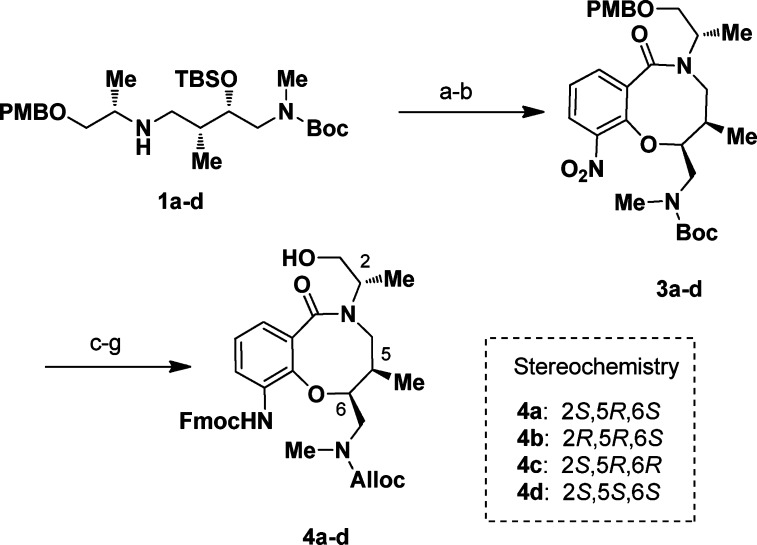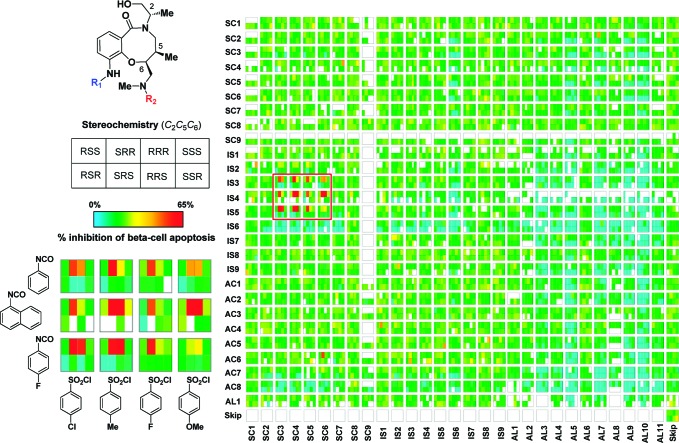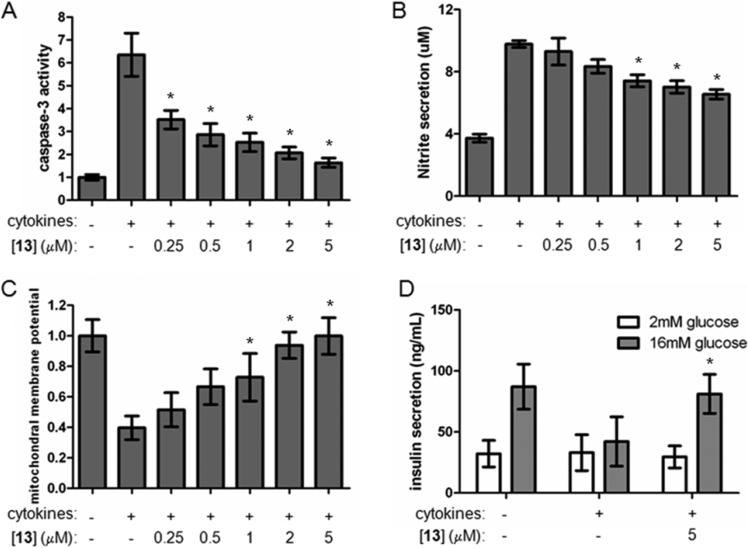Abstract
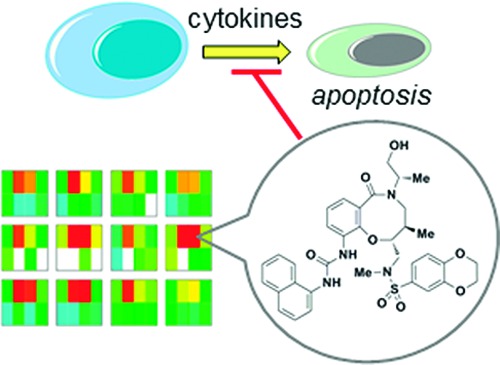
The synthesis of a stereochemically diverse library of medium-sized rings accessible via a “build/couple/pair” strategy is described. Key aspects of the synthesis include SNAr cycloetherification of a linear amine template to afford eight stereoisomeric eight-membered lactams and subsequent solid-phase diversification of these scaffolds to yield a 6488-membered library. Screening of this compound collection in a cell-based assay for the suppression of cytokine-induced β-cell apoptosis resulted in the identification of a small-molecule suppressor capable of restoring glucose-stimulated insulin secretion in a rat β-cell line. The presence of all stereoisomers in the screening collection enabled preliminary determination of the structural and stereochemical requirements for cellular activity, while efficient follow-up chemistry afforded BRD0476 (probe ML187), which had an approximately 3-fold increase in activity. These results demonstrate the utility of diversity-oriented synthesis to probe discovery using cell-based screening and the importance of including stereochemical diversity in screening collections for the development of stereo/structure–activity relationships.
Keywords: Diversity-oriented synthesis, screening collection, diabetes, beta cell, apoptosis
Type-1 diabetes is caused by the autoimmune destruction of insulin-producing β-cells in the pancreas. The infiltration of pancreatic islets by macrophages and secretion of inflammatory cytokines such as IL-1β, IFN-γ, and TNF-α are believed to cause β-cell death.1 Activation of transcription factors such as NFkB and STAT1 by these cytokines triggers the intrinsic apoptotic pathway in both rodent and human cell models.2 A small-molecule probe capable of preventing or reversing cytokine-induced β-cell death could have great potential in developing therapies for early stage type 1 diabetes.
Previous efforts to suppress β-cell apoptosis with small molecules involved compounds with antioxidant or antiinflammatory activity3,4 and, more recently, with inhibitors of histone deacetylase activity.5,6 Previously, we described a suite of cell-based assays that can be used to identify small-molecule suppressors of β-cell death and examined the effects of inhibitors of glycogen synthase kinase 3β.7 This pilot-scale screen identified small molecules that increased ATP levels, but the majority of these compounds did not have effects on other aspects of β-cell biology, such as insulin secretion. Therefore, we sought to identify more complete suppressors of β-cell apoptosis that allowed for normal β-cell function.
Diversity-oriented synthesis (DOS)8−10 has emerged as a practical strategy to assemble compound libraries with a high degree of stereochemical and skeletal diversity, serving to augment traditional screening collections of commercially available compounds and natural products.9,11−17 DOS compounds rival natural products in terms of complexity (as measured by sp3 content and the presence of stereogenic centers)18−20 yet are designed to be easily modified to facilitate downstream chemistry optimization. These principles were highlighted recently by an aldol-based “build/couple/pair” (B/C/P) strategy, resulting in a collection of various medium- and large-sized rings derived from a common linear intermediate.21,22 We sought to capitalize on this versatile intermediate to increase further the diversity of our compound collection. Building on our past success with the SNAr reaction for cycloetherification,22 we aimed to build a library that would provide both structure–activity relationships (SAR) and stereochemical structure–activity relationships (SSAR) in primary screens for biological activity. Coupling this information with the ability to synthesize analogues rapidly, exploiting short, modular synthetic pathways, provides a quick and efficient process to optimize hits identified in high-throughput screening (HTS). Here, we describe the development of a stereochemically diverse library of medium-sized rings and the results of a screening campaign for the suppression of β-cell apoptosis. Further optimization of the initial hit cluster and follow-up biological studies resulted in a compound capable of restoring physiological properties to β-cells in the presence of pro-inflammatory cytokines.
The synthesis of the library scaffolds commenced with linear intermediate 1, which was accessed by coupling a suitably protected γ-amino acid with an amino alcohol, followed by reduction of the resulting amide.22 All stereoisomers of both the γ-amino acid and the amino alcohol were coupled together, resulting in the generation of 1a–d and ent-1a–d, allowing for the full stereochemical matrix of scaffolds to be synthesized. Acylation of 1a–d with 2-fluoro-3-nitrobenzoic acid chloride (2) proceeded smoothly to give the precursor to the key step, an intramolecular SNAr reaction (Scheme 1). While we had anticipated that stereochemistry might play a role in the efficiency of the ring formation,22 all stereoisomers reacted smoothly with cesium fluoride for desilylation followed by cyclization to give desired 3a–d in excellent yield. Functional group manipulation to prepare for solid-phase library production was achieved through a stepwise process involving: (1) nitro reduction and subsequent protection of the aniline as the Fmoc carbamate, (2) protecting group exchange from the incompatible Boc group to an Alloc, and (3) PMB removal to reveal the site for immobilization onto solid support. The sequence was high yielding and could be carried out on a multigram scale.
Scheme 1.
With all stereoisomers of 4 prepared, we turned our attention to library production. Immobilization of the scaffold first involved activation of SynPhase Lanterns with triflic acid to give the silyl triflate, followed by exposure with the scaffold in the presence of 2,6-lutidine (Scheme 2). Typical loading levels for the immobilization step were 15–18 μmol/Lantern. Removal of the Fmoc-protecting group under standard conditions followed by capping with sulfonyl chlorides, isocyanates, acid chlorides, or formaldehyde (27 building blocks or skip) introduced the first appendage diversity (R1) at the aniline. Palladium-mediated Alloc deprotection in the presence of barbaturic acid revealed the second appendage diversity site (R2) at the amine, which was capped with sulfonyl chlorides, isocyanates, acids, or aldehydes (29 building blocks or skip). Release from solid support was achieved with HF/pyridine, yielding an average of 14.1 μmol of each final compound per Lantern. All possible combinations of building blocks were used for each stereoisomer (except where R1 = skip) to afford a 6488-membered library. All compounds were analyzed by ultraperformance liquid chromatography (UPLC), and those samples with purity >75% at 210 nm (5820 compounds, 90% pass rate) were submitted for HTS.
Scheme 2.
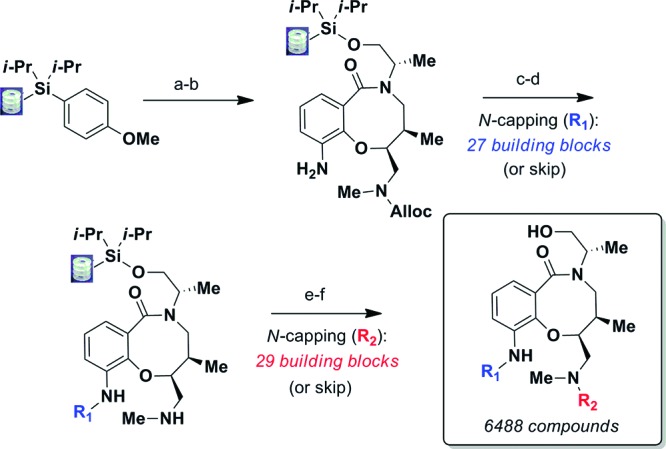
The SNAr-based library was included with other DOS and commercial libraries in a HTS campaign designed to identify suppressors of cytokine-induced β-cell apoptosis. The rat β-cell line INS-1E23 was treated in 384-well format with this library in the presence of a cocktail of pro-inflammatory cytokines (IL-1β, IFN-γ, and TNF-α) for 48 h. Luciferase-based measurement of cellular ATP levels was used as a surrogate of cell viability.7 Several DOS compounds partially restored β-cell viability in the presence of these cytokines, and we were able to determine some SSAR features from the primary assay. As shown in Figure 1, lactams 4c and ent-4d were the preferred stereoisomers, demonstrating the importance of the stereochemistry within the eight-membered ring. The 5R,6R stereochemistry was required for activity, while the configuration of the excocyclic stereocenter was less critical. Urea substituents appeared to be favored at the aniline position, as compared to sulfonamides and amides. At the amine position, sulfonamides resulted in greater ATP levels as compared to ureas and amines. (2S,5R,6R)-5 was the most potent member of the library, with an EC50 of 4.9 μM in restoring β-cell viability.
Figure 1.
Primary screening data displayed as percent inhibition of beta-cell apoptosis. A total of 6488 compounds derived from eight stereoisomeric SNAr scaffolds were tested. The full matrix of building blocks for R1 (y-axis) and R2 (x-axis) is shown. Empty cells represent compounds that were not tested due to low purity or unavailability. Highlighted blocks represent the top-scoring compounds identified in the primary screen.
Using compound 5 as a starting point, additional SARs were explored via the preparation of a variety of analogues and subsequent testing for the restoration of cellular ATP levels in INS-1E cells as a readout. We first explored the nature of the urea substituent at R1. On the basis of primary screening results, the bulky napthyl substituent appeared to be preferred over simple phenyl groups; thus, we focused on subtle modifications to the napthyl ring. As shown in Table 1, saturation of the napthyl ring was not tolerated (compounds 6 and 7), nor was replacement with a benzofuran ring (compound 8). We next explored modifications to the sulfonamide at R2. When the para-methoxyl group was moved to either the ortho- or the meta-position (compound 9 and 10), the activity was abolished. Replacement with a more bulky phenoxy group (compound 11) also resulted in a loss of activity. Potency was retained and even increased with the introduction of a m,p-disubstituted analogues (compound 12 and 13). Compound 13 (BRD0476, probe ML18724) in particular was a potent suppressor of β-cell death, resulting in the best performance among all analogues, with an EC50 of 0.78 μM and 99% maximum activity. The 2,3-dichlorophenyl urea was also synthesized and tested (compound 14) to explore further the replacement of the napthyl ring; however, this compound was inactive. Removal of the primary alcohol did not affect activity (compound 15 and 16).
Table 1. EC50 (μM) and Maximum Activity of Synthesized Analogues in Restoring β-Cell Viability.
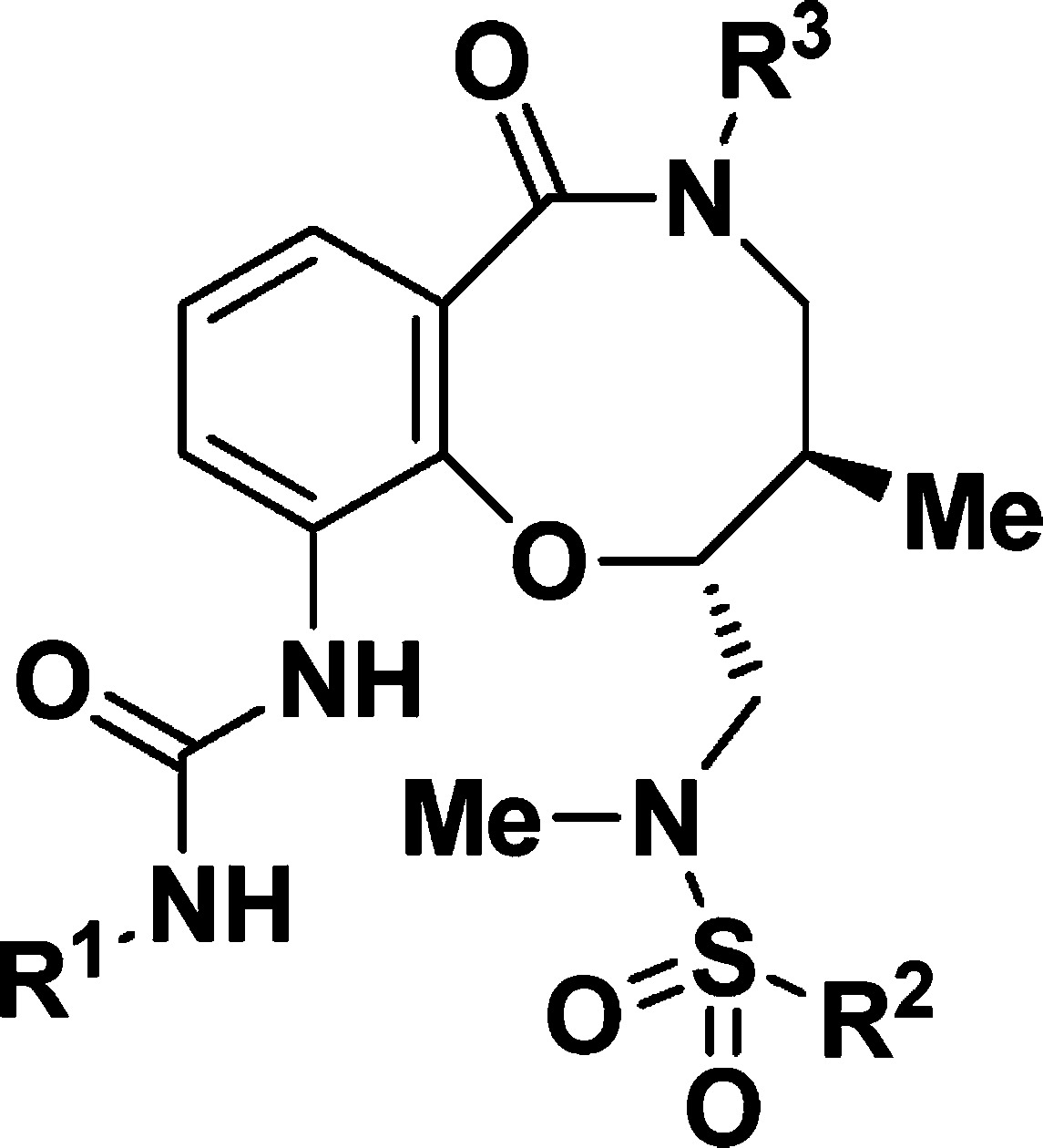
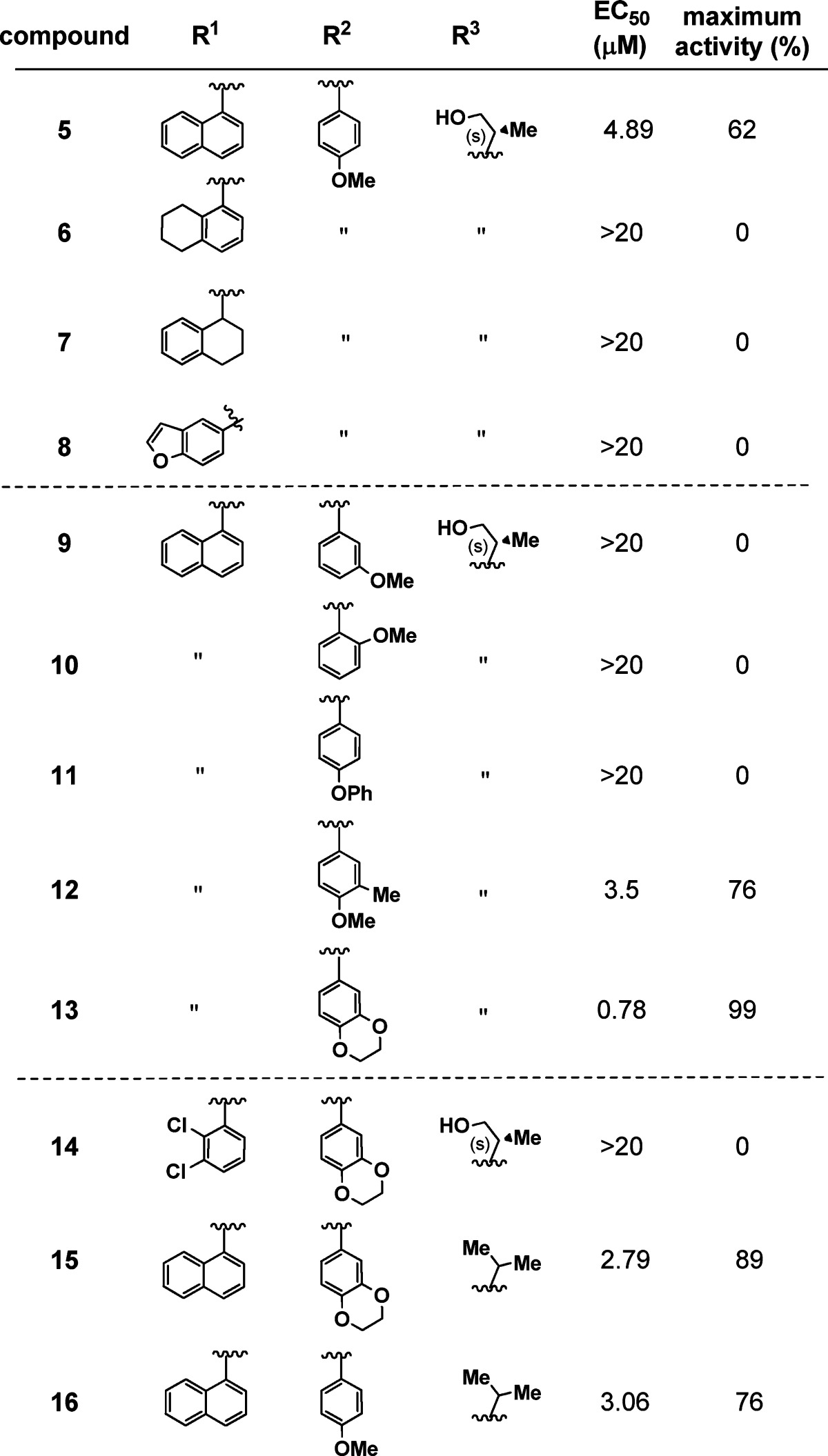
The most potent analogue, compound 13 (BRD0476), was chosen for further characterization of its effects on different aspects of β-cell biology. Caspase-3 activity is normally highly elevated in apoptotic β-cells.1 Pro-inflammatory cytokines induced a 6.5-fold increase in caspase-3 activity (Figure 2A). Treatment with 13 in the presence of cytokines reduced caspase-3 activity in a dose-dependent manner. IL-1β is known to induce gene expression of nitric oxide synthase (iNOS), an effect that is potentiated by IFN-γ.25 The subsequent formation of NO drives cell death by both necrosis and apoptosis. Nitrite production is a surrogate measurement of nitric oxide generated by cytokine-treated INS-1E cells and is measured colorimetrically using the Griess reagent (a commercially available mixture of naphthylenediamine dihydrochloride and sulfanilamide). Compound 13 induced a dose-dependent decrease in the production of nitrite (Figure 2B), although the effect was more modest than caspase-3 activity. Cytokine-mediated β-cell apoptosis has been reported to cause a loss of the mitochondrial membrane potential (ΔΨm). JC-1 is a dye commonly used to measure ΔΨm. Mitochondrial membrane potential was reduced 2.5-fold in the presence of cytokines and is restored to normal levels by treatment with compound 13 (Figure 2C). Finally, glucose-stimulated insulin secretion (GSIS) is one of the most important physiological functions of β-cells. After brief starvation followed by challenge with high (16 mM) glucose levels, β-cells secrete insulin into the cell culture media. GSIS was abolished after 2 days of treatment with pro-inflammatory cytokines; however, simultaneous treatment with 5 μM compound 13 restored GSIS to nearly normal levels (Figure 2D).
Figure 2.
Cellular effects of 13 in cytokine-induced β-cell death. (A) Effects of 13 on caspase-3 activity after 48 h of treatment. (B) Effects of 13 on the cellular production of nitrite after 48 h of treatment. (C) Effects of 13 on mitochondrial membrane potential of nitrite after 48 h of treatment. (D) Effects of 13 on glucose-stimulated insulin secretion after 48 h of treatment. Data represent the mean ± standard deviation of eight independent wells for insulin secretion and 24 independent wells for A–C. * indicates p < 0.01 as compared to the cytokine treatment alone.
In summary, we have expanded on past efforts to identify novel small-molecule suppressors of cytokine-induced β-cell apoptosis. These results show that the improved DOS analogue 13 (BRD0476, probe ML18724) protected rat β-cells from pro-inflammatory cytokines and may represent a viable strategy to protecting pancreatic β-cells in the context of type-1 diabetes. Ongoing efforts are currently focused on the identification of the lead compound's mechanism of action, which will be the basis of a future publication.
Acknowledgments
We thank Prof. Stuart L. Schreiber for encouraging the undertaking of this project and mentorship of D.H.-C.C. as well as Dr. Michael Foley and Dr. Sivaraman Dandapani for helpful discussions, Dr. Stephen Johnston for analytical support, and Anita Vrcic for sorting, cleavage and formatting of library members.
This work was funded in part by the NIGMS-sponsored Center of Excellence in Chemical Methodology and Library Development (Broad Institute CMLD with Prof. Stuart L. Schreiber serving as P.I. and L.A.M. as Project Leader for the work described here; P50 GM069721), the NIH Genomics Based Drug Discovery U54 grants Discovery Pipeline RL1CA133834 with Prof. Todd Golub serving as P.I. (administratively linked to NIH Grants RL1HG004671, RL1GM084437, and UL1DE019585), the NIH-MLPCN program (1 U54 HG005032-1 awarded to S.L.S.), and a Type-1 Diabetes Pathfinder Award (NIH-NIDDK) to B.K.W. D.H.-C.C. is a Vertex Scholar.
Supporting Information Available
Experimental procedures and spectral data for all new compounds. This material is available free of charge via the Internet at http://pubs.acs.org.
Author Present Address
† H3 Biomedicine Inc., 300 Technology Square, Cambridge, Massachusetts 02139.
Funding Statement
National Institutes of Health, United States
Supplementary Material
References
- Cnop M.; Welsh N.; Jonas J. C.; Jorns A.; Lenzen S.; Eizirik D. L. Mechanisms of pancreatic beta-cell death in type 1 and type 2 diabetes: Many differences, few similarities. Diabetes 2005, 54Suppl. 2S97–S107. [DOI] [PubMed] [Google Scholar]
- Grunnet L. G.; Aikin R.; Tonnesen M. F.; Paraskevas S.; Blaabjerg L.; Storling J.; Rosenberg L.; Billestrup N.; Maysinger D.; Mandrup-Poulsen T. Proinflammatory cytokines activate the intrinsic apoptotic pathway in beta-cells. Diabetes 2009, 58, 1807–1815. [DOI] [PMC free article] [PubMed] [Google Scholar]
- Kim E. K.; Kwon K. B.; Song M. Y.; Han M. J.; Lee J. H.; Lee Y. R.; Ryu D. G.; Park B. H.; Park J. W. Flavonoids protect against cytokine-induced pancreatic beta-cell damage through suppression of nuclear factor kappaB activation. Pancreas 2007, 35, e1–e9. [DOI] [PubMed] [Google Scholar]
- Matsuda T.; Ferreri K.; Todorov I.; Kuroda Y.; Smith C. V.; Kandeel F.; Mullen Y. Silymarin protects pancreatic beta-cells against cytokine-mediated toxicity: Implication of c-Jun NH2-terminal kinase and janus kinase/signal transducer and activator of transcription pathways. Endocrinology 2005, 146, 175–185. [DOI] [PubMed] [Google Scholar]
- Larsen L.; Tonnesen M.; Ronn S. G.; Storling J.; Jorgensen S.; Mascagni P.; Dinarello C. A.; Billestrup N.; Mandrup-Poulsen T. Inhibition of histone deacetylases prevents cytokine-induced toxicity in beta cells. Diabetologia 2007, 50, 779–789. [DOI] [PubMed] [Google Scholar]
- Lewis E. C.; Blaabjerg L.; Storling J.; Ronn S. G.; Mascagni P.; Dinarello C. A.; Mandrup-Poulsen T. The oral histone deacetylase inhibitor ITF2357 reduces cytokines and protects islet beta-cells in vivo and in vitro. Mol. Med. 2011, 17, 369–377. [DOI] [PMC free article] [PubMed] [Google Scholar]
- Chou D. H.; Bodycombe N. E.; Carrinski H. A.; Lewis T. A.; Clemons P. A.; Schreiber S. L.; Wagner B. K. Small-molecule suppressors of cytokine-induced beta-cell apoptosis. ACS Chem. Biol. 2010, 5, 729–734. [DOI] [PMC free article] [PubMed] [Google Scholar]
- Burke M. D.; Schreiber S. L. A planning strategy for diversity-oriented synthesis. Angew. Chem., Int. Ed. 2004, 43, 46–58. [DOI] [PubMed] [Google Scholar]
- Schreiber S. L. Target-oriented and diversity-oriented organic synthesis in drug discovery. Science 2000, 287, 1964–1969. [DOI] [PubMed] [Google Scholar]
- Nielsen T. E.; Schreiber S. L. Towards the optimal screening collection: A synthesis strategy. Angew. Chem., Int. Ed. 2008, 47, 48–56. [DOI] [PMC free article] [PubMed] [Google Scholar]
- Bauer R. A.; Wurst J. M.; Tan D. S. Expanding the range of 'druggable' targets with natural product-based libraries: an academic perspective. Curr. Opin. Chem. Biol. 2010, 14, 308–314. [DOI] [PMC free article] [PubMed] [Google Scholar]
- Goess B. C.; Hannoush R. N.; Chan L. K.; Kirchhausen T.; Shair M. D. Synthesis of a 10,000-membered library of molecules resembling carpanone and discovery of vesicular traffic inhibitors. J. Am. Chem. Soc. 2006, 128, 5391–5403. [DOI] [PMC free article] [PubMed] [Google Scholar]
- Hubel K.; Lessmann T.; Waldmann H. Chemical biology—Identification of small molecule modulators of cellular activity by natural product inspired synthesis. Chem. Soc. Rev. 2008, 37, 1361–1374. [DOI] [PubMed] [Google Scholar]
- Koch M. A.; Schuffenhauer A.; Scheck M.; Wetzel S.; Casaulta M.; Odermatt A.; Ertl P.; Waldmann H. Charting biologically relevant chemical space: A structural classification of natural products (SCONP). Proc. Natl. Acad. Sci. U.S.A. 2005, 102, 17272–17277. [DOI] [PMC free article] [PubMed] [Google Scholar]
- Marcaurelle L. A.; Johannes C.; Yohannes D.; Tillotson B. P.; Mann D. Diversity-oriented synthesis of a cytisine-inspired pyridone library leading to the discovery of novel inhibitors of Bcl-2. Bioorg. Med. Chem. Lett. 2009, 19, 2500–2503. [DOI] [PubMed] [Google Scholar]
- Marcaurelle L. A.; Johannes C. W. Application of natural product-inspired diversity-oriented synthesis to drug discovery. Prog. Drug Res. 2008, 66, 189–216. [DOI] [PubMed] [Google Scholar]
- Pelish H. E.; Westwood N. J.; Feng Y.; Kirchhausen T.; Shair M. D. Use of biomimetic diversity-oriented synthesis to discover galanthamine-like molecules with biological properties beyond those of the natural product. J. Am. Chem. Soc. 2001, 123, 6740–6741. [DOI] [PubMed] [Google Scholar]
- Dandapani S.; Marcaurelle L. A. Accessing new chemical space for 'undruggable' targets. Nat. Chem. Biol. 2010, 6, 861–863. [DOI] [PubMed] [Google Scholar]
- Lovering F.; Bikker J.; Humblet C. Escape from flatland: Increasing saturation as an approach to improving clinical success. J. Med. Chem. 2009, 52, 6752–6756. [DOI] [PubMed] [Google Scholar]
- Comer E.; Liu H.; Joliton A.; Clabaut A.; Johnson C.; Akella L. B.; Marcaurelle L. A.. Fragment-based domain shuffling approach for the synthesis of pyran based macrocycles. Proc. Natl. Acad. Sci. U.S.A. 2011, 108, 6751−6756. [DOI] [PMC free article] [PubMed] [Google Scholar]
- Gerard B.; Duvall J. R.; Lowe J. T.; Murillo T.; Wei J.; Akella L. B.; Marcaurelle L. A.. ACS Comb. Sci. 2011, DOI: 10.1021/co2000218 [DOI] [PMC free article] [PubMed]
- Marcaurelle L. A.; Comer E.; Dandapani S.; Duvall J. R.; Gerard B.; Kesavan S.; Lee M. D. IV; Liu H.; Lowe J. T.; Marie J.-C.; Mulrooney C. A.; Pandya B. A.; Rowley A.; Ryba T. D.; Suh B.-C.; Wei J.; Young D. W.; Akella L. B.; Ross N. T.; Zhang Y. L.; Fass D. M.; Reis S. A.; Zhao W. N.; Haggarty S. J.; Palmer M.; Foley M. A. An aldol-based build/couple/pair strategy for the synthesis of medium- and large-sized rings: Discovery of macrocyclic histone deacetylase inhibitors. J. Am. Chem. Soc. 2010, 132, 16962–16976. [DOI] [PMC free article] [PubMed] [Google Scholar]
- Merglen A.; Theander S.; Rubi B.; Chaffard G.; Wollheim C. B.; Maechler P. Glucose sensitivity and metabolism-secretion coupling studied during two-year continuous culture in INS-1E insulinoma cells. Endocrinology 2004, 145, 667–678. [DOI] [PubMed] [Google Scholar]
- This compound has been registered with NIH Molecular Libraries Program (probe ML187) and is available upon request.
- Darville M. I.; Eizirik D. L. Regulation by cytokines of the inducible nitric oxide synthase promoter in insulin-producing cells. Diabetologia 1998, 41, 1101–1108. [DOI] [PubMed] [Google Scholar]
Associated Data
This section collects any data citations, data availability statements, or supplementary materials included in this article.



